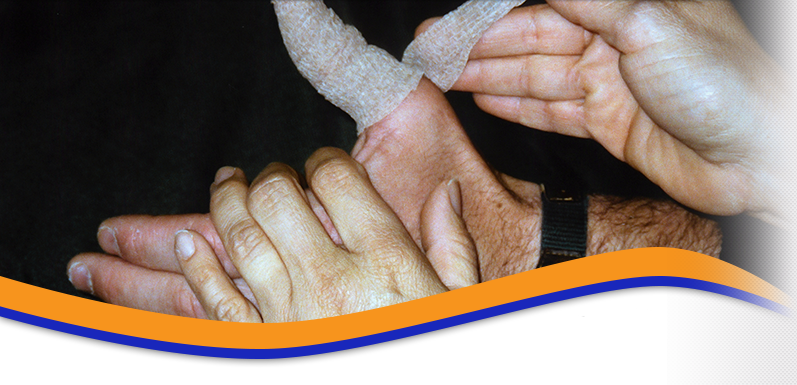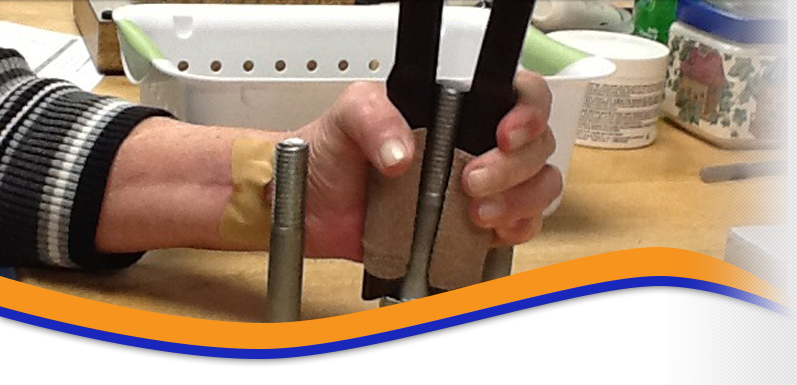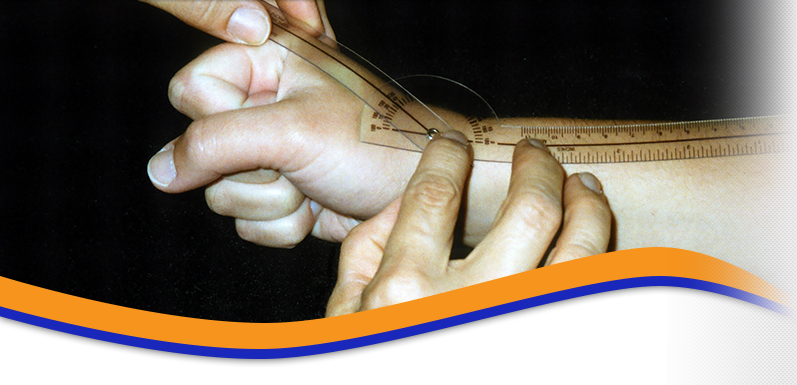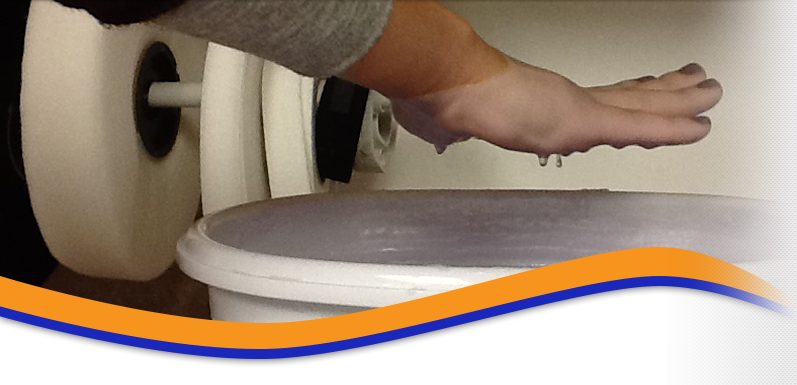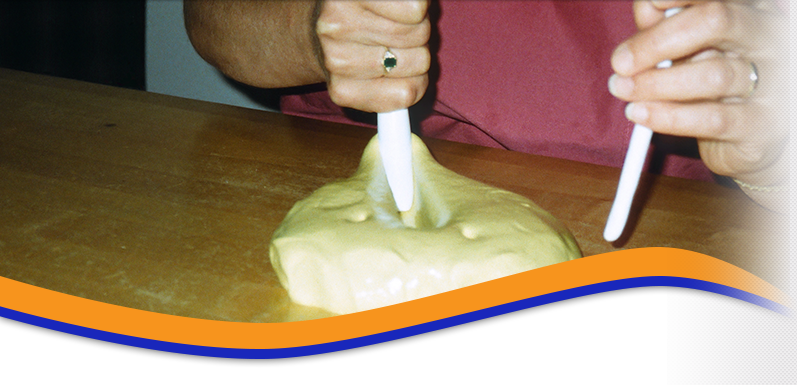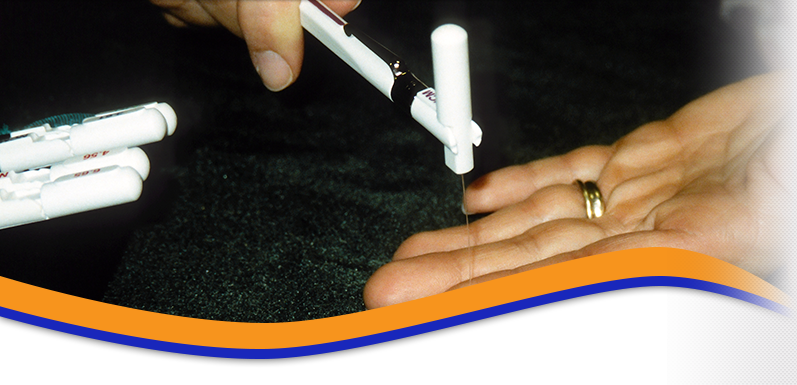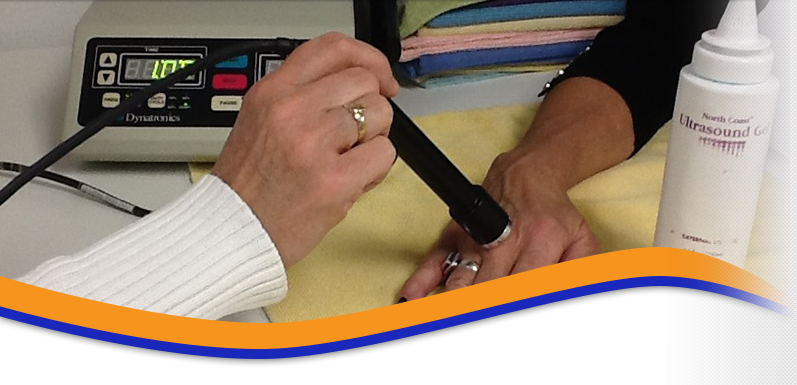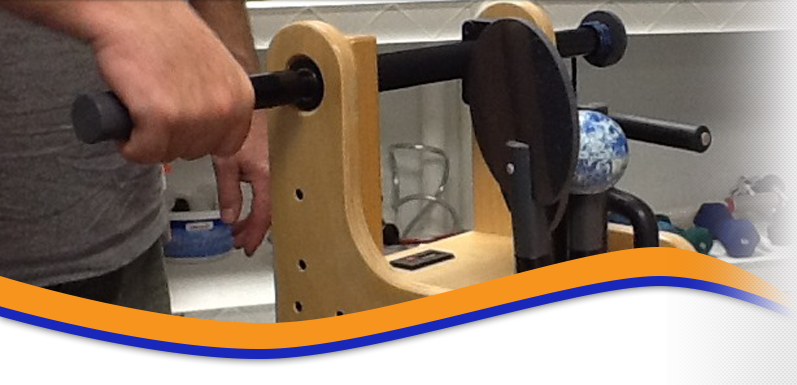Zone I Mallet (Conservative)
0-8 weeks s/p: Patient is fitted with a custom DIP ext splint with DIP in slight hyperextension if possible. Patient is instructed in AROM of PIP and MP.
8-12 weeks s/p: Patient weans from splint to night wear only. GAROM are initiated to the DIP, heat modalities and swelling control measures are added to therapy program.
12 weeks s/p: All splinting is discontinued unless there is an extension lag greater than 10 degrees. If an extension lag is present and greater than 10 degrees night splinting is continued. AROM, PROM and progressive strengthening are incorporated into therapy program to restore full functional use of hand.
Zone I (Boney Mallet)
3 days post-op: A protective splint is fabricated with care not to put pressure on pin. AROM and PROM (if necessary) are initiated to PIP and MP joints. Pin care is done and patient is instructed in cleaning pin and precautions to prevent infection.
6 weeks post-op: (after pin is removed by M.D.) AROM exercises are initiated to DIP and added to home exercise program 6 times daily. Heat modalities and swelling control measures are added to therapy program. Patient is fitted with a mallet splint to hold DIP extended in between exercise sessions and at night.
7 weeks post-op: PROM may be added if there is no extensor lag, mallet splint is continued.
9 weeks post-op: Initiate weaning of mallet splint
10 weeks post-op: Discontinue splint during the day. Progressive strengthening exercises are incorporated into therapy program if OK’d by M.D. to restore full functional use of hand.
12 weeks post-op: Discontinue splint at night
Zone I (Tendon Repair)
3 days post-op: Dressings removed, DIP extension splint fabricated, A/PROM initiated to MP and PIP. Swelling control measures are taken.
6 weeks post-op: AROM initiated to DIP. Splint is continued between exercise sessions and at night.
7 weeks post-op: GPROM may be initiated if there is not an extensor lag.
8 weeks post-op: Splint is gradually weaned during the day.
9 weeks post-op: Splint is discontinued during the day.
10 weeks post-op: Night splinting is discontinued as long as there isn’t an extensor lag greater than 10 degrees. Progressive strengthening exercises are incorporated into therapy program to restore full functional use of hand.
Zone II, III and IV
Lateral band repair
3-5 days post-op: Dressings removed, wound car initiated, swelling control measures taken, gutter splint fabricated that includes PIP and DIP in full extension.
10-14 days post-op: Scar mobilization initiated when wound is healed.
3 weeks post-op: Splint is removed 6 times daily for AROM exercises, swelling control and scar mobilization continue.
4 weeks post-op: AAROM is added if needed.
5 weeks post-op: PROM is added if needed if there is no extensor lag, gutter splint is discontinued during the day so patient may begin to use hand for normal ADLs (nothing heavy)
6 weeks post-op: Splint is discontinued. Progressive strengthening exercises are incorporated into therapy program to restore full functional use of hand.
Zone II, III and IV
Central slip laceration or avulsion, lacerations to lateral bands and/or triangular ligament
3 days post-op: Dressing is removed, light compressive dressing is applied and a finger gutter splint is fabricated with PIP and DIP in full extension.
10-14 days post-op: after suture removal scar maturation techniques are initiated.
4 weeks post-op: AROM is initiated with patient instructed in a home exercise program to be performed 4-6 times daily in addition to continued swelling control measures and scar maturation techniques. Patient is to continue to wear gutter splint between exercise sessions.
6 weeks post-op: If extensor lag is less than 10 degrees PROM may be added to exercise program. Splint is continued between exercises.
7 weeks post-op: Dynamic flexion splinting may be added if needed to improve flexion. Care is taken to not increase extensor lag. If lag increases splinting is decreased. Weaning from the gutter splint during the day is initiated.
8 weeks post-op: Gutter splint is discontinued during the day if extensor lag is 10 degrees or less. It is continued at night. Gentle strengthening is initiated.
9 weeks post-op: Gutter splint is completely discontinued.
Zone III and IV
Central Slip laceration or rupture:
0-6 weeks s/p: Swelling control measures are taken and a volar gutter splint is fabricated with a dorsal component over the proximal phalanx to hold the PIP in full extension. Patient is instructed to exercise the DIP both actively and passively 10-20 reps ever waking hour. All uninjured joints of the hand are exercised as needed.
6 weeks s/p: AROM of the PIP is initiated and patient is instructed to exercise at home 4-6 times daily. The splint is continued between exercise sessions. Heat modality is started in therapy to decrease pain and increase soft tissue extensibility. Scar maturation techniques and swelling control measures are taken as needed.
7 weeks s/p: PROM may be added to program if needed and if the extension lag is less than 10 degrees. PROM is avoided if the extension lag is greater than 10 degrees. Weaning of splint wear during the day is initiated.
8-10 weeks s/p: Flexion splinting may be added at this time if needed. Gentle strengthening may be initiated. The extension splint is discontinued completely at 10 weeks s/p.
Zone III and IV
Thomes and Thomes Protocol
2-7 days post-op: A hand based splint is fabricated with MP flexed to 0-20 degrees of flexion, PIP held in neutral with dynamic traction allowing 30 degrees of active PIP flexion using a stop bead on the traction line. The finger loop rests against the outrigger to prevent continuous extension forces to the PIP. The DIP is free. Patient is instructed to flex PIP to stop bead 10-20 times every 1-2 hours. Full ROM is allowed for DIP and wrist.
2 weeks post-op: 40 degrees of PIP flexion is allowed
3 weeks post-op: 50 degrees of PIP flexion is allowed
4 weeks post-op: Traction is discontinued during exercises and active extension is allowed.
5 weeks post-op: Splint is discontinued
6 weeks post-op: Passive and resistive flexion can be initiated.
Chronic Boutonniere: (treatment initiated 3 weeks or greater post injury)
Full passive PIP extension is achieved through serial casting or dynamic splinting.
Once patient has full passive extension immobilization of the PIP is continued with a cast or splint for 8 weeks. The patient is instructed in both active and passive DIP range of motion exercises every waking hour.
After 8 weeks of immobilization, the patient is started on AROM exercises to the PIP in addition to the DIP exercises 6-8 times daily. A splint to hold the PIP in full extension is continued between exercise sessions and at night.
At 9 weeks from the start of the immobilization period dynamic flexion splinting may be initiated if the extensor lag is minimal.
At 10-12 from the start of the immobilization period extension splinting is gradually weaned and then completely discontinued.
Zone V and VI:
Saggital band and Partial extension tendon repair:
3-5 days post-op: Hand based MP and IP extension splint is fabricated with joints in full extension, finger adjacent to the injured finger may be included in splint. Patient is instructed in AROM to uninvolved digits. Swelling control measures are taken.
10-14 days post-op: Scar massage and mobilization is initiated.
3 weeks s/p: AROM is initiated and patient is instructed to complete exercises 4-6 times a day. Splinting is continued between exercises.
6 weeks post-op: PROM may be initiated. Dynamic flexion splinting may be initiated if needed. Extension splinting is discontinued during the day be continued at night.
7 weeks post-op: Night extension splint is discontinued.
8 weeks post-op: Gentle strengthening is initiated.
Extensor tendon repairs:
3-5 days post-op: A forearm based wrist and MP extension splint is fabricated with wrist at 20 degrees extension and MPs in full extension. AROM to IPs is initiated. Swelling control measures are taken.
10-14 days post-op: Scar maturation techniques are initiated.
4 weeks post-op: AROM exercises are initiated to wrist and MPs. Patient is instructed to complete exercises 4-6 times daily. Ultrasound may be initiated if scar is thick and adherent to tendon. The wrist and MP extension splint is continued between exercise sessions.
6 weeks post-op: AAROM and/or PROM exercises may be added to program. A dynamic flexion splint may be added 3-4 times daily. Static wrist and MP splint is continued.
7 weeks post-op: If extensor lag is less than 15 degrees the static splint may be gradually weaned during the day. Gentle strengthening may be initiated.
Zones VII and VIII:
Extensor tendon repair:
3-5 days post-op: A forearm based wrist and MP extension splint is fabricated with wrist at 30 degrees extension and MPs in full extension. AROM to IPs is initiated. Swelling control measures are taken.
10-14 days post-op: Scar maturation techniques are initiated.
4 weeks post-op: AROM exercises are initiated to wrist and MPs. Patient is instructed to complete exercises 4-6 times daily. Ultrasound may be initiated if scar is thick and adherent to tendon. The wrist and MP extension splint is continued between exercise sessions.
6 weeks post-op: AAROM and/or PROM exercises may be added to program. A dynamic flexion splint may be added and worn up to 6 hours daily. Static wrist and MP splint is continued.
7 weeks post-op: If extensor lag is less than 25 degrees the static splint may be gradually weaned during the day. Gentle strengthening may be initiated.
10 weeks post-op: The static extension splint is discontinued.
Zones V, VI, VII and VIII
Early Mobilization program
Indicated for complex extensor tendon injuries where the periosteum is involved, or there is a rigid boney fixation or extensive soft tissue involvement.
3-5 days post-op: Patient is fitted with a dorsal forearm based dynamic finger extension splint and a volar flexion block. The wrist should be positioned in 40 degrees of extension and the dynamic traction should hold the MPs in neutral. The splint should allow 30 degrees of index and long MP flexion and 35 degrees of ring and small MP flexion. The finger slings should block flexion of the PIP and DIP joints. The patient is instructed to flex MPs to the volar block and relax to allow the traction to bring the fingers back up into neutral 10-15 reps every waking hour. The patient is also fitted with a static volar forearm based splint which positions the wrist in 30 degrees of extension and MPs in full extension. The patient is instructed in how to hold the wrist and digits in full extension when changing splints. The patient is instructed in to exercise the IPs 2 times daily in the night splint. Once in the AM before donning the dynamic splint and once in the evening after donning the static splint the IP exercises are performed.
10-14 days post-op: Scar maturation techniques are initiated.
3 weeks post-op: Patient is allowed to actively assist extension when performing exercises.
4 weeks post-op: AROM is initiated to the wrist and fingers every waking hour. The static splint is worn between exercise sessions and at night. The dynamic splint is discontinued. Ultrasound may be initiated if scar is dense and adherent. Isolated passive wrist flexion may be added if needed.
6 weeks post-op: AAROM and PROM may be initiated to wrist and fingers
7 weeks post-op: Patient is weaned from static splint during the day. Progressive strengthening is initiated.
9-10 weeks post-op: Splinting is discontinued.
EPL repair:
3-5 days post-op: Swelling control measures are taken. A static forearm based wrist and thumb splint is fabricated. The wrist is held in 20 degrees of extension and thumb CMC held midway between radial and palmar abduction and IP in slight hyperextension. Splint is worn at all times.
10-14 days post-op: Scar maturation techniques are added.
4 weeks post-op: AROM exercises to wrist and thumb are initiated. Static splinting is continued between exercises. Desensitization activities are initiated if needed.
6 weeks post-op: AAROM and/or PROM exercise may be initiated to the wrist and thumb. The static wrist and thumb splint is gradually weaned from daytime wear. An IP gutter splint that positions the IP in hyperextension, may be needed if an extensor lag is present.
7 weeks post-op: Dynamic flexion splinting may be added to program if needed.
Putty is initiated as well as, progressive strengthening. Static splinting may be discontinued.
EPB and APL repair:
3-5 days post-op: Swelling control measures are taken. A static forearm based wrist and thumb splint is fabricated. The wrist is held in 20 degrees of extension and thumb CMC held midway between radial and palmar abduction and the IP is free. Splint is worn at all times. Patient is instructed to perform AROM exercises to thumb IP and fingers.
10-14 days post-op: Scar maturation techniques are initiated. Desensitization is initiated.
3 weeks post-op: AROM is initiated to wrist and thumb. Patient continues to wear splint between exercises.
5 weeks post-op: Splint is weaned from day and night use.
6 weeks post-op: Progressive strengthening is initiated.
Extensor tendon subluxation
Conservative treatment:
0-3 weeks s/p: Patient is fitted with a static forearm based MP extension splint with wrist at 20 degrees of extension and MPs in neutral. Patient is instructed in AROM to IPs in the splint.
3 weeks s/p: AROM is initiated to the wrist and MPs 4-6 times daily. Splint is continued between exercise sessions.
6 weeks s/p: AAROM and PROM may be added if needed. The splint is continued.
8 weeks s/p: The splint is discontinued.
Extensor tendon Repostioning:
3-5 days post-op: Patient is fitted with a static forearm based MP extension splint with wrist at 15 degrees of extension and MPs in neutral. Patient is instructed in AROM to IPs in the splint. Swelling control measures are taken.
10-14 days post-op: Scar maturation techniques are initiated.
3 weeks post-op: A forearm based dynamic MP extension splint is fabricated for patient to wear with AROM exercises of the MPs. The static splint is continued between exercise sessions.
6 weeks post-op: AAROM may be initiated as needed.
7 weeks post-op: PROM may be initiated as needed. Dynamic flexion splinting may be added. The dynamic extension splint may be discontinued if extensor lag is less than 15 degrees.
8 weeks post-op: The static splint may be weaned from day and night wear. Progressive strengthening is added.

